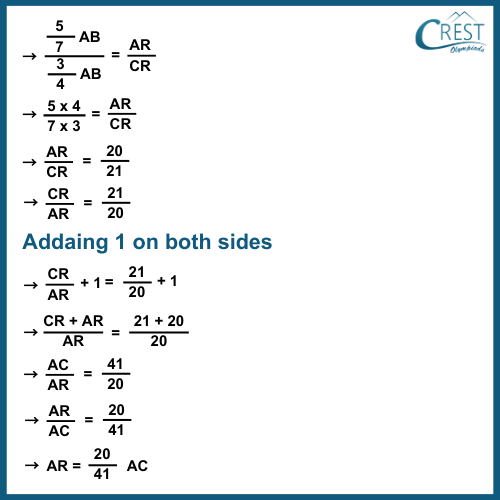Solved Questions on Triangles and its Properties
1. In △ABC, AB = 7 cm, BC = 3.5 cm, CA = 2√2 cm, ∠A = 75° and ∠B = 47° and in △PQR, PQ = 21 cm, QR = 10.5 cm, RP = 6√2 cm. What is the value of ∠P?
a) 75°
b) 47°
c) 58°
d) 68°
Answer: c) 58°
Explanation: We are given that in △ABC, AB = 7 cm, BC = 3.5 cm, CA = 2√2 cm, ∠A = 75° and ∠B = 47°.
In △PQR, PQ = 21 cm, QR = 10.5 cm, RP = 6√2 cm.
The figure is shown below:
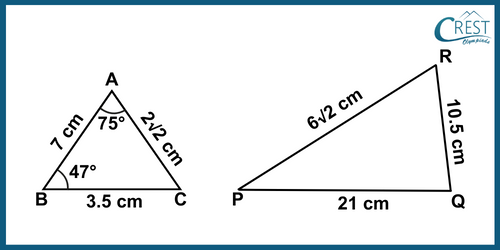
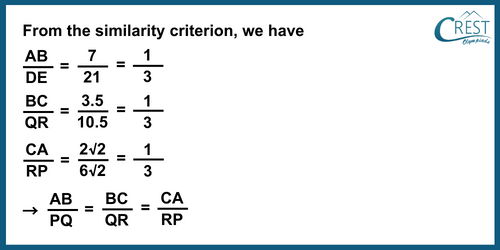
According to SSS (Side-Side-Side) Similarity Criterion,
△ABC ~ △PQR
Thus, ∠C = ∠P [Corresponding angles of the similar triangles]
We know that the sum of all angles of a triangle is 180°.
In △ABC,
∠A + ∠B + ∠C = 180°
75° + 47° + ∠C = 180°
122° + ∠C = 180°
∠C = 180° − 122°
∠C = 58°
Since ∠C = ∠P
∠P = 58°
2. Consider the following statements:
(i) If A and B are the points on the sides PQ and PR of △PQR such that
PQ = 21 cm, PA = 6 cm, BR = 20 cm and PB = 8 cm, then AB || QR.
(ii) If in △ABC and △PQR, ∠A = 38°, ∠B = 57°, ∠P = 85° and ∠Q = 57°, then △BAC ~ △RQP.
Out of the following, which statement is TRUE?
a) Only (i)
b) Only (ii)
c) Both (i) and (ii)
d) Neither (i) nor (ii)
Answer: a) Only (i)
Explanation:
Consider Statement (i): We are given PQ = 21 cm, PA = 6 cm, BR = 20 cm and PB = 8 cm
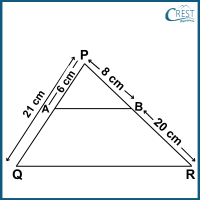
Thus, AQ = PQ − PA
AQ = 21 − 6
AQ = 15 cm
Now, PA/AQ = 6/15 = 2/5
Also, PB/BR = 8/20 = 2/5
PA/AQ = PB/BR
The converse of basic proportionality theorem states that if a line divides any two sides of a triangle in the same ratio, then the line is parallel to the third side.
Thus, AB || QR
Thus, statement (i) is TRUE.
Consider Statement (ii):
We are given that in △ABC and △PQR, ∠A = 38°, ∠B = 57°, ∠P = 85° and ∠Q = 57°.
We know that the sum of all angles of a triangle is 180°.
Thus, in △ABC,
∠A + ∠B + ∠C = 180°
38° + 57° + ∠C = 180°
95° + ∠C = 180°
∠C = 180° − 95°
∠C = 85°
Now in △PQR,
∠P + ∠Q + ∠R = 180°
85° + 57° + ∠R = 180°
142° + ∠R = 180°
∠R = 180° − 142°
∠R = 38°
Thus, in △BAC and △QRP,
∠A = ∠R = 38°
∠B = ∠Q = 57°
∠C = ∠P = 85°
Thus, by AAA similarity
△BAC ~ △QRP
Thus, statement (ii) is FALSE.
Therefore, Only (i) is TRUE.
3. Consider the figure given below:
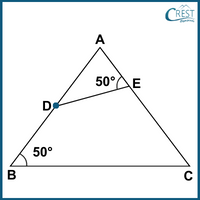
ABC is a triangle with ∠B = 50° and AB = 12 cm. ADE is another triangle with ∠AED = 50°, AD = 7 cm and AE = 5 cm. What is the length of EC?
a) 11. 5 cm
b) 11.75 cm
c) 11.6 cm
d) 11.8 cm
Answer: d) 11.8 cm
Explanation: The given figure is shown as:
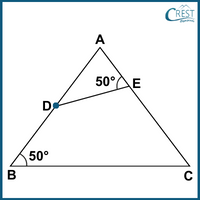
Let ∠A = θ
In △ABC and △AED,
∠BAC = ∠DAE (Common)
∠ABC = ∠AED = 50° (Given)
Thus, by AA similarity criterion,
△ABC ~ △AED
AC / AD = AB / AE = BC / ED
Taking AC / AD = AB / AE
AC / 7 = 12 / 5
AC = (12 × 7) / 5
AC = 84 / 5
Now, AC = AE + EC
EC = AC − AE
= (84 / 5) − 5
= (84 − 25) / 5
= 59 / 5
= 11.8 cm
∴ EC = 11.8 cm
4. In a trapezium ABCD, AB || DC and DC = 3AB. EF drawn parallel to AB cuts AD at F and BC at E such that BE/EC = . If diagonal DB intersects EF at G, then which of the following is correct?
a) EF = 2AB
b) 9EF = 17AB
c) 9EF = 16AB
d) 9EF = 19AB
Answer: b) 9EF = 17AB
Explanation: The figure is shown below:
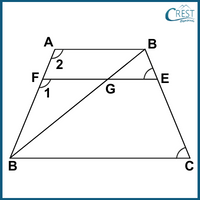
We are given that DC = 3AB and =
In △DFG and △DAB,
∠DFG = ∠DAB [Corresponding angles since AB || FG]
∠FDG = ∠ADB [Common]
We know that if two angles of one triangle are respectively equal to two angles of another triangle, then the two triangles are similar by AA similarity criteria.
△DFG ~ △DAB [By AA similarity]
Thus, DF⁄DA = FG⁄AB … (1)
In trapezium ABCD, AB || EF || CD
AF⁄FD = BE⁄EC
But BE⁄EC = 4⁄5
AF⁄FD = 4⁄5
Adding 1 on both the sides
AF⁄FD + 1 = 4⁄5 + 1
=
AD⁄FD = 9⁄5
FD⁄AD = 5⁄9 … (2)
From equation (1) and (2),
FG⁄AB = 5⁄9
FG = 5⁄9AB … (3)
In △BEG and △BCD,
∠BEG = ∠BCD [Corresponding angles since EG || CD]
∠GBE = ∠DBC [Common]
We know that if two angles of one triangle are respectively equal to two angles of another triangle, then the two triangles are similar by AA similarity criteria.
△BEG ~ △BCD [By AA similarity]
Thus, BE⁄BC = EG⁄CD
We know that BE⁄EC = 4⁄5
EC⁄BE = 5⁄4
Adding 1 on both sides
+ 1 = + 1
=
EC⁄BE = 9⁄4
BE⁄EC = 4⁄9
But BE⁄BC = EG⁄CD
EG⁄CD = 4⁄9
EG = 4⁄9CD
We know that CD = 3AB
EG = 4⁄9(3AB)
EG = 12⁄9AB … (4)
Adding equation (3) and (4),
FG + EG = 5⁄9AB + 12⁄9AB
EF = 17⁄9AB
9EF = 17AB
5. ABCD is a parallelogram in the given figure. AB is divided at P and CD at Q such that AP : PB = 5 : 2 and CQ : QD = 3 : 1. If PQ meets AC at R, then which of the following is true?
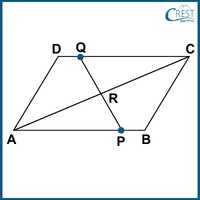
a) AR = 21⁄40AC
b) AR = 21⁄41AC
c) AR = 20⁄41AC
d) AR = 23⁄40AC
Answer: c) AR = 20⁄41AC
Explanation: In △APR and △CQR,
∠PAR = ∠QCR [Alternate interior angles since AB || CQ]
∠ARP = ∠CRQ [Vertically opposite angles]
We know that if two angles of one triangle are respectively equal to two angles of another triangle, then the two triangles are similar by AA similarity criteria.
△APR ~ △CQR [By AA similarity]
AP⁄CQ = PR⁄QR = AR⁄CR … (1)
We are given that AP : PB = 5 : 2
=
=
=
AP = 5⁄7AB
We are given that CQ : QD = 3 : 1
=
= 3⁄3 + 1
= 3⁄4
CQ = 3⁄4CD
Since ABCD is a parallelogram, its opposite sides are equal
AB = CD
CQ = 3⁄4AB
From equation (1), we have
AP⁄CQ = AR⁄CR
Substituting AP =AB and CQ = AB in the above equation
